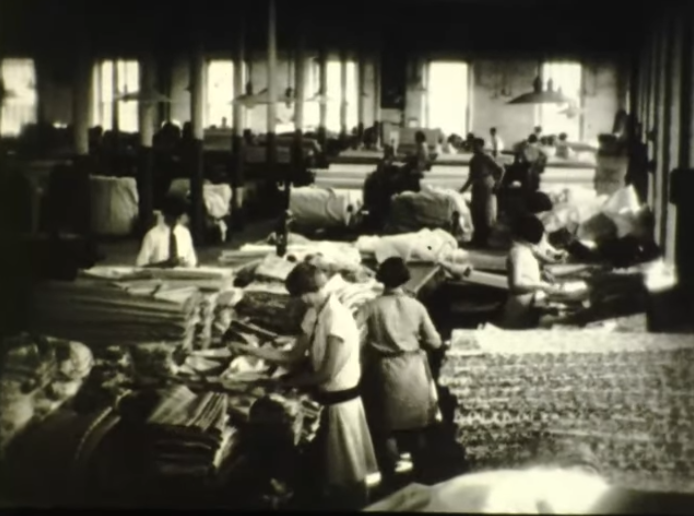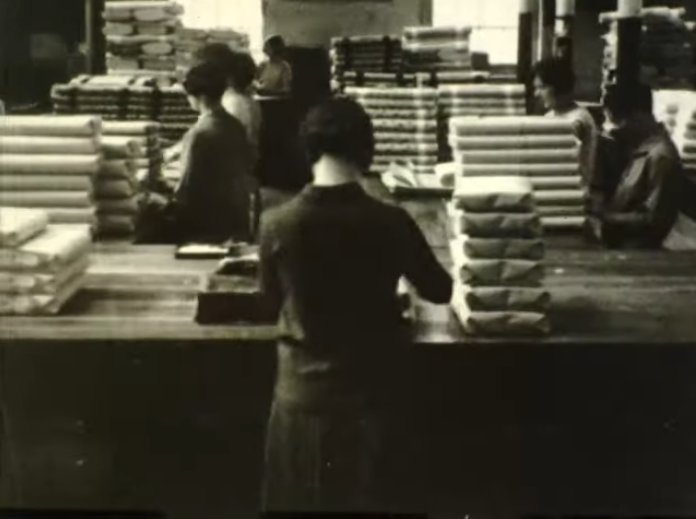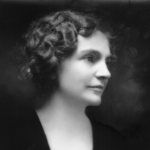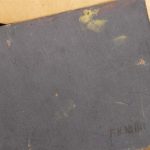Film history fascinates me.
I was first introduced to silent film while in my teens via a 1980 Thames Television thirteen-episode documentary series called Hollywood: A Celebration of the American Silent Film – brilliant.
Shortly thereafter, through a fortuitous conversation with a Mr. and Mrs. who were long-time FRHS members and supporters, rather well connected in New York social and cultural scenes – of old Fall River stock both, they had moved to New York City after their marriage in 1925, where the Mr. was very closely associated with the Harkness family – I was encouraged to write to a lady acquaintance of theirs, who knew something about silent film.
Somewhat of an understatement.
The lady acquaintance: Lillian Gish (1893-1993).
They provided an address, to which I dispatched a note.
Much to my astonishment, the pioneering film actress – the First Lady of American Cinema – wrote back.
I responded, as one would.
As did she.
As did I.
As did she.
And so, for several years, we exchanged the occasional letter, note, or card; she sent me the two books she authored, and several inscribed photographs – she was lovely, and a great lady.
Through Miss Gish, I was introduced, via mail or telephone, to a few other ladies of the silent screen, among them Colleen Moore (1899-1988), of whom F. Scott Fitzgerald famously wrote: “I was the spark that lit up Flaming Youth, Colleen Moore was the torch. What little things we are to have caused all that trouble.” She was very nice: There were some letters, a few inscribed photographs, and she sent me her book – the memoirs, not her other book, How Women Can Make Money in the Stock Market. She certainly knew that subject; perceived as a Flapper, the actress was, in fact, a shrewd woman of business; she was also very down-to-earth. In addition to her film legacy there is her famous doll house – extravagance in miniature – preserved in the collection of the Museum of Science and Industry, Chicago.
And there were a few others: Leatrice Joy (1893-1985), Billie Dove (1903-1997), Bessie Love (1898-1986), and … well, you get the picture.
And so, due to a chance comment during a conversation with a New York couple who I grew to respect and admire, and who were very kind to me – they always considered Fall River “home” – a kid from the North End came into contact with a few ageing ladies who, in their day, had been well-known actresses.
Good memories, those.
I still have the books, the letters, and the photographs.
But once again, I digress.
Now, to the point.
Film is historically important and provides the only remaining cinematic evidence of cultural heritage that has vanished or changed with the passage of time. Film documenting the history of the city of Fall River, Massachusetts, is exceedingly rare and has survived only by chance.
The earliest film footage pertaining to Fall River that has surfaced to date documents the aftermath of the devastating conflagration – known as the Great Fire of 1928 – that destroyed a vast stretch of the northern portion of the downtown business district on February 2-3, 1928. This film is preserved in the collection of the FRHS.
I heard many stories about the ’28 Fire from people who were there – Florence Cook Brigham (1899-2000): “After seeing the 1928 fire, I never wanted to see another. Dick (her husband) made me go.” Her father, Benjamin Cook Jr. (1870-1962), was, at the time, a Special Justice of the Second District Court and an attorney, with an office in the Granite Block; the building was totally destroyed in the fire. When his office floor collapsed, the safe in which he housed his legal documents landed in the Quequechan River and broke open. As a result: “Father had to rewrite all his wills and contracts because they ended up in the Taunton River.”
Many of my old Friends remembered the night of the fire for another reason: In several households, it was maid’s night off, so they recalled being at table having “a cold supper” when the fire broke out in the Pocasset Mill at about 5:45 in the evening.
“Mother didn’t cook, you know.”
Classic Fall River, that, at least for those who lived on “the Hill.”
References to film footage of a February 15, 1916, conflagration that engulfed the southern section of the downtown business district – the Great Fire of 1916 – appear in the FRHS collection, in the form of notes in Mrs. B’s hand. I do not know if she actually saw the film, or just heard about it, but if it exists it has not yet surfaced.
It is accepted by film historians that more than ninety percent of all film made before 1920, and fifty percent made before 1950, has been lost due to the unstable nature of the medium, coupled with inadequate storage. Cellulose nitrate film base is extremely flammable and is known to auto-ignite. It fades and decomposes, with the acrid vinegar-like odor emanating from old film canisters – called “vinegar syndrome” – signaling its death knell.
It is very eye-wateringly-pungent, believe me.
Yet despite oftentimes sub-par storage conditions, important footage has managed to survive and, when digitized, once again flickers – time-machine-like – magically transporting the viewer to another time and place.
In this instance:
A late 1920s Fall River textile mill – “the Largest in the World”; and a fashion show, with Hollywood starlets of the silent era modeling outfits cut from that same mill’s “Latest Cotton Creations.”
A recent email:
“Michael, I hope you are well. I just got about 50 old films digitized and the result came back this past weekend. I thought you would like these two.”
The message came from Tom Borden. He is a great-great-grandson of print cloth magnate Matthew Chaloner Durfee Borden (1842-1912), a.k.a. “the Calico King,” who reorganized the failed American Print Works as the American Printing Company – it became the largest print cloth manufactory in the world.
In brief:
M.C.D. Borden was an astutely brilliant industrialist. He knew the risks and was prepared to take them, seized available opportunities, and prospered. A real Fall River blueblood of the oldest Yankee stock, he was the son of Colonel Richard Borden (1795-1874) – his mother was a Durfee; when he married the daughter of Dr. Nathan Durfee (1799-1876), his first cousin became his mother-in-law, and when he fathered children, his aunt became their great-grandmother. Fascinating genealogy, but very confusing to the uninitiated.
Much like the manner in which he applied his business acumen, Borden pursued his cultural interests in similar fashion and at the highest levels: A collector of old and modern masters, his private gallery housed renowned works of art, among them Lucretia by Rembrandt (now in the National Gallery), and The Third Class Carriage by Daumier (now in The Met). He compiled a library of rare first editions, folio manuscripts and letters, and antiquities … amazing.
There are many artifacts pertaining to this family preserved in the FRHS collections.
I spent nearly a decade searching for his full-length portrait, painted in 1901 by Théobold Chartran (1849-1907), and thought lost – it was not. The massive painting is a testament to Gilded Age achievement and now hangs at the FRHS; an interesting story, that, but one for another time.
Now, back to Tom’s email, which ended:
“Have you seen these before?”
Intriguing, that.
I followed the links and was dumbfounded by what I saw – stunned, actually.
My follow-up answer.
An astounding “NO!”
I had never seen anything like it.
Astonishing.
Absolutely astonishing.
The films:
The New Cotton Vogue.
The two short, promotional films – silent and captioned with title cards – were filmed and edited for M.C.B. Borden & Sons by Joseph Weil and released in 1929. Expensive to produce and featurette-like in quality, they were likely intended to be shown to moviegoers during the widely-popular newsreel presentations preceding feature films or in newsreel theatres.
One of the films – running time 15 minutes and 37 seconds – features “Fashions in Borden Fabrics,” the clothing all “original creations” in the latest mode, with some ensembles modelled by “Universal Picture Stars.” The names Mary Philbin (1902-1993) or Dorothy Gulliver (1908-1997) may ring a bell with some people today … but perhaps, not. Suffice it to say that to 1929 moviegoers, they were recognizable.
In short, it is a beautifully produced advertisement – a fashion show – for Borden fabric, marketed during the last halcyon days of the Roaring Twenties, shortly before the Great Crash ushered in the Great Depression.
Students of fashion history will find it particularly enjoyable, as will people interested in Fall River history – it offers a rare glimpse of Fall River fabric “in action,” and who alive today can boast having seen that? A bit tedious, perhaps, but well worth viewing.
But it is the other film – running time 14 minutes and 7 seconds – that is the most important, significant to the point of being earthshattering.
Why?
Because it is a unique cinematic record of Fall River industrial history.
The film documents the various stages of cotton cloth manufacturing, from the cotton fields of the south – filmed characteristic of the era and idealized with smiling, African-American child laborers – to the gritty inner workings of a massive Fall River textile mill complex. Though silent on film, the cacophonous, repetitive noise that was generated by tons of machinery in operation – and the heavily accented human voices, straining to be heard over it – can easily be imagined. Members of Fall River’s multi-cultural labor force are engaged in every phase of cloth production, from unloading heavy bales of raw cotton trucked to the mill from the Fall River waterfront, to final distribution of the finished product.
It is riveting.
Those of us who had ancestors that worked in Fall River’s mills and had asked them of those days know something of their experiences through recollections – told, oftentimes, in brief reference – or, rarer yet, through workplace photographs in which they appeared, an identified face in a mass of anonymity. In one such photograph, from my grandmother’s things and now in the FRHS collection, my paternal grandfather is depicted.
But now, this static perception of a Fall River textile mill has been altered.
In the animated faces of the men and women depicted in The New Cotton Vogue – cogs in the industrial wheel that was Fall River – are the visages of our ancestors.
No longer do we imagine what it was like.
Now we see.
This is a Holy Grail of Fall River industrial history.
Its significance cannot be overstated.
The FRHS is indebted to Tom and Julie Borden for preserving this unique evidence of Fall River’s cultural heritage – and of their Borden family history – and for sharing it with the public.
So now, back to 1929 Fall River.
The tone is set by title cards: “Fall River, Mass – The Borden Mills, Largest in the World ….” and “Shopping for New Dresses.”
The journey in time begins.











